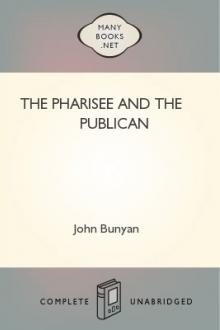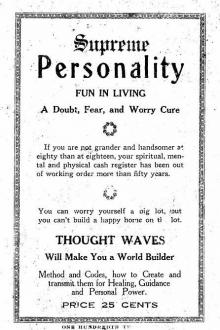Science and the Infinite, Sydney T. Klein [well read books TXT] 📗

- Author: Sydney T. Klein
- Performer: -
Book online «Science and the Infinite, Sydney T. Klein [well read books TXT] 📗». Author Sydney T. Klein
Now let us come to the closing years of the tenth century. What a strange condition of the building craft was to be seen all over Europe; not a church was being built, nor had been built, for the last twenty years; the thousand years after Christ was drawing to its close, everybody was waiting for, and expecting, the world to come to an end; no new undertakings were begun. How much money went into the hands of the Monasteries and other Religious Houses, as peace offerings for the future welfare of the givers, nobody can say; it was probably enormous. When, however, the eleventh century was well started and the crisis was over, churches were built on a large scale, as shown by the numerous remains we have of Norman buildings of the last half eleventh century, and building was probably at its height about a.d. 1140 to 1150; but at this period an extraordinary thing happened. Hitherto the arches in the Norman style were round-headed and their columns enormously thick to carry them; but suddenly the style changed into the beautiful Gothic all over Europe. No single country can claim precedence, it was almost simultaneous; churches half finished in the round style were not only completed in the pointed, but had parts already built altered to the new style. What, then, determined this sudden change, resulting in a wonderful accession of beauty to Architectural design? We must go to the Monasteries and Religious Houses to find the explanation. These Houses had become the Patrons of Masonry, the providers of the funds for building Cathedrals, &c.; it naturally followed that, growing up alongside the Operative Science, there was a Religious symbolism being gradually formed which attached itself specially to the tools used by Masons, and thus formed the basis of Moral teaching—"to act on the Square," "to keep within the bounds of the Compasses," "to be Level in all your dealings," &c., &c. A wonderful, new, and Mystical form of Symbolism was opened to them with the advent of Geometry. The text-book of Geometry was unknown throughout the whole of Europe, omitting Spain, from the sixth to the beginning of the twelfth century; it was, as I have pointed out, well known in Greece before our Era, and continued to be so up to about the sixth century a.d. In the fourth century lived the Greek, Theon of Alexandria, so well known for his edition of Euclid's Elements, with notes, from which all Greek MSS. which first came to light in the sixteenth century were taken, being entitled εκ των Θεωνος συνουσιων, "from Theon's Lectures," and which he probably used as a text-book in his classes; but these MSS. had all been lost before the seventh century, and were not recovered again until the sixteenth century, when Simon Grynæus, the greatest Greek scholar on the Continent, and companion of Melancthon and Luther, discovered a copy in Constantinople. Meanwhile, Theon's edition had been translated into Arabic, and thus preserved by the Mohammedans, and it was only at the beginning of the twelfth century that Athelard of Bath, who had been travelling in the East, came to study at Cordova, in Spain, and there found the Arabic MSS. of Euclid; these he translated into Latin, and this translation must have come into the hands of the patrons of the building craft at the very time when the Gothic style had its origin; it was the only Latin translation known in Europe, and was, some centuries later, the text-book of the first printed edition of Euclid.
The Operative Masons had always formed their Right-Angled Triangles by means of mundane measures of 3, 4, and 5 units to each side respectively, as was done by the Harpedonaptæ of Egypt 5000 years ago, and 2500 years later by Pythagoras, and this same method continues to be used to this day; but to those of a religious turn of mind, who had only lately become conversant with Euclid, and looked upon Geometry not only as the height of all learning, but, as they progressed in the knowledge of its bearing on the Science of building, actually made it synonymous with Tectonic Art (the old MSS. which have come down to us from that time invariably state that "at the head of all the Sciences stands Geometry which is Masonry"), there must have come a wave of wonderful enthusiasm when they first discovered that the Geometrical way of creating a Right Angle, as given in Euclid I. ii., was by means of an Equilateral Triangle, by joining the Apex with the centre of the base. This Equilateral Triangle was the earliest symbol we know of the Divine Logos in connection with that wonderful figure the Vesica Piscis; and as the Bible declared that the Universe was created by the Logos (the Word), so the Square which represented the Universe was naturally created by means of the Equilateral Triangle. A great mystery this must have appeared to those who, like the Hellenic philosophers, postulated that everything on Earth has its counterpart in Heaven, and who, in their religious mysticism, were always looking for signs of the transcendental in their temporal surroundings.
But in what awe and reverence must they have held Geometry, when they further found that the Equilateral Triangle, representing the Logos, was itself generated, as shown in the first Problem of Euclid, upon which the whole Science of Geometry was therefore based, by the intersection of two Circles! These two Circles were held by the Greeks, at the beginning of our Era, to represent the Past and Future Eternities generating the Logos; but the whole figure (Euclid I. i.) was at the time we are now dealing with looked upon by Mediæval Architects as representing the Three Divine personæ, and that part, or cavity, of the figure which is bounded by the Arcs of the two circles, and which takes to itself one-third of each of the two generating circles (making its perifera exactly equal with that remaining to each of the two circles, all three therefore being co-equal), and in which the Equilateral Triangle is formed (vide frontispiece), was naturally held by the Mediæval Architects, and indeed from earliest times, as the most sacred Christian Emblem—namely, that of Regeneration or "New Birth."
The Cavity is evidently referred to in the Mystical Gospel of St. John (iii. 16), in the question by and answer to Nicodemus, and it was the eye of the needle referred to in St. Mark x. 25, in answer to the question in verse 17, and again in St. Luke xviii. 25. In later ages this symbol was extensively used by the Christian Church to surround the "Soul of a Saint" after death (illustrated in Magister Mathesios). The date of the birth of a Saint was always given as the date on which he or she died and had been born again in the Spiritual Life, and the Saint was depicted in a Vesica Piscis, the vulva of the Ruach or Holy Spirit, representing this new birth. To show the extraordinary reverence and high value attached to this symbol, it is only necessary to remember that, from the fourth century, when Theon of Alexandria lectured on Geometry, and onwards, all Seals of Colleges, Abbeys, Monasteries, and other religious communities, as well as of ecclesiastical persons, have been made invariably of this form, and they continue to be made so to this day. It was also in allusion to this most sacred ancient emblem that Tertullian, and other early Fathers, spoke of Christians as "Pisciculi." It was called the "Vesica Piscis" (Fish's Bladder), and named, no doubt, by the Greeks at the beginning of our Era, for the purpose of misleading the ignorant from the true meaning of the Figure.
One can well understand the object which led the learned Rabbi Maimonides, the greatest savant of the Middle Ages, when addressing his pupils in the twelfth century, to command his hearers: "When you have discovered the meaning thereof, do not divulge it, because the people cannot philosophise nor understand that to the Infinite there is no such thing as Sex;" but later on the noted writer on Symbolism, Durandus, in the introduction to his book, is more explicit, and gives the real meaning as follows: "The Mystical Vesica Piscis ... wherein the Divinity and, more rarely, the Blessed Virgin are represented, has no reference, except in name, to a fish, but represents the Almond, the symbol of Virginity and self-production."
The Vesica Piscis, and its name, is intimately connected with the discovery, by Augustus Cæsar in the century preceding our Era, as narrated by Baronius, of a prophecy in one of the Sibylline books, foretelling "a great event coming to pass in the birth of One who should prove to be the true 'King of Kings,' and Augustus Cæsar therefore dedicated an altar in his palace to this unknown God." Eusebius and St. Augustine inform us that the first letter of each line of the verses from the Erythrean Sibyl containing this prophecy, formed the word ΙΧΘΥΣ (a fish), and were taken as representing the sentence: Ιησους Χριστος Θεου Υἱος Σωτηρ ("Jesus Christ, the Son of God, the Saviour"). Based upon this discovery arose that extraordinary enthusiasm, during the second, third, and fourth centuries, for hunting up further prophecies in Pagan sources, resulting in a great number of Sibylline verses being invented, giving the minutest details in the Life of our Lord. These fabrications seem to have been at that time generally accepted by the masses as true prophecies, though we know now that they were written some centuries after the events they were supposed to foretell.
Let us now return to the Vesica Piscis. In the paintings and sculptures of the Middle Ages, we find it constantly used to circumscribe the figure of the Saviour, especially whenever He is represented as judging the world and in His glorified state. Many beautiful examples of this in Anglo-Saxon work of the tenth century may be seen in King Edgar's Book of Grants to Winchester Cathedral and the famous Breviary of St. Ethelwolfe. Numerous illustrations of these and other pictures of the Middle Ages, as also diagrams of the properties of the Vesica Piscis, can be seen in the volume I have already referred to dealing fully with this subject.
The building fraternity was a purely Christian community; the First Crusade raised a great enthusiasm for building Christian Churches, and brought in large gifts of money for that purpose. Up to 1140 Norman Architecture held sway, having the "Square" for its unit, its greatest symbol being the Gnomon, representing knowledge; but about that time, as we have seen, arose from the study of Geometry, the head of all learning, a Mystical form having the mysterious figure of the Vesica Piscis, the true Gothic Arch, with the Equilateral Triangle enclosed as its unit, and symbolising the Trinity in Unity. The recognition of the import of the Trinity was paramount throughout those early days; all important documents began with an Invocation of the Tres Personæ, or were garnished with symbolic illustrations thereof; all the old MSS., already referred to, which have come down to us from that period, invariably commence with "In the name of the Father and of the Son and of the Holy Ghost."
It can therefore be readily understood what determined the sudden change between 1140-1150, resulting in that wonderful accession of beauty to architectural design which we find in the Gothic. The incentive had to be a strong one, and of an eminently religious character, to accomplish the radical change of throwing over so absolutely the Norman, and commencing to build entirely on what are called





Comments (0)